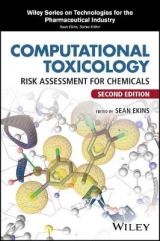
Computational Toxicology
Wiley-Blackwell (Verlag)
978-0-470-04962-4 (ISBN)
- Titel ist leider vergriffen;
keine Neuauflage - Artikel merken
A comprehensive analysis of state-of-the-art molecular modeling approaches and strategies applied to risk assessment for pharmaceutical and environmental chemicals This unique volume describes how the interaction of molecules with toxicologically relevant targets can be predicted using computer-based tools utilizing X-ray crystal structures or homology, receptor, pharmacophore, and quantitative structure activity relationship (QSAR) models of human proteins. It covers the in vitro models used, newer technologies, and regulatory aspects.
The book offers a complete systems perspective to risk assessment prediction, discussing experimental and computational approaches in detail, with: An introduction to toxicology methods and an explanation of computational methods In-depth reviews of QSAR methods applied to enzymes, transporters, nuclear receptors, and ion channels Sections on applying computers to toxicology assessment in the pharmaceutical industry and in the environmental arena Chapters written by leading international experts Figures that illustrate computational models and references for further information This is a key resource for toxicologists and scientists in the pharmaceutical industry and environmental sciences as well as researchers involved in ADMET, drug discovery, and technology and software development.
Sean Ekins, MSc, PhD, DSc, is Senior Vice President of Computational Biology, Arnold Consultancy and Technologies, and an Adjunct Associate Professor in the Department of Pharmaceutical Sciences, University of Maryland School of Pharmacy. Dr. Ekins has authored more than eighty peer-reviewed papers and book chapters as well as several patents. He serves on scientific advisory boards and editorial boards for six journals and consults for biotechnology companies on ADMET, systems biology, and in vitro approaches. He previously edited Computer Applications in Pharmaceutical Research and Development (Wiley).
Series Introduction. Preface. Acknowledgments. Contributors. PART I: INTRODUCTION TO TOXICOLOGY METHODS. 1. An Introduction to Toxicology and Its Methodologies (Alan B. Combs and Daniel Acosta Jr.). 2. In Vitro Toxicology: Bringing The In Silico and In Vivo World Closer (Jinghai J. Xu). 3. Physiologically-Based Pharmacokinetic/Pharmacodynamic Modeling (Brad Reisfeld, Arthur N. Mayeno, Michael A. Lyons and Raymond S. H. Yang). 4. Species Differences In Receptor-Mediated Gene Regulation (Edward L. LeCluyse and J. Craig Rowlands). 5. Toxicogenomics and Systems Toxicology (Michael D. Waters, Jennifer M. Fostel, Barbara A. Wetmore and B. Alex Merrick). PART II: COMPUTATIONAL METHODS. 6. Toxicoinformatics: An Introduction (William J. Welsh, Weida Tong and Panos G. Georgopoulos). 7. Computational Approaches for Assessment of Toxicity - A Historical Perspective and Current Status (Vijay K Gombar, Brian E Mattioni, Craig Zwickl and Thom Deahl). 8. Current QSAR Techniques for Toxicology (Yu Zong Chen, Chun Wei Yap and Hu Li). PART III. APPLYING COMPUTERS TO TOXICOLOGY ASSESSMENT: PHARMACEUTICAL. 9. The Prediction of Physicochemical Properties (Igor V Tetko). 10. Applications of QSAR to Enzymes Involved In Toxicology (Sean Ekins). 11. QSAR-Studies on Drug Transporters Involved In Toxicology (Gerhard F. Ecker and Peter Chiba). 12. Computational Modeling of Receptor-Mediated Toxicity. (Angelo Vedani and Markus Lill). 13. Applications Of QSAR Methods To Ion Channels (Alex M. Aronov, Konstantin V. Balakin, Alex Kiselyov, Shikha Varma-O'Brien and Sean Ekins). 14. Predictive Mutagenicity Computer Models (Laura L. Custer, Constantine Kreatsoulas and Stephen K. Durham). 15. Novel Applications of Kernel-Partial Least Squares to Modeling A Comprehensive Array Of Properties For Drug Discovery (Sean Ekins, Mark J. Embrechts, Curt M. Breneman, Kam Jim and Jean-Pierre Wery). 16. Homology Models Applied To Toxicology (Stewart B. Kirton, Phillip J. Stansfeld, John S. Mitcheson and Michael J. Sutcliffe). 17. Crystal Structures Of Toxicology Targets (Frank E. Blaney and Ben G. Tehan). 18. Expert Systems (Philip Judson). 19. Strategies for Using Computational Toxicology Methods in Pharmaceutical R&D (Lutz Muller, Alexander Breidenbach, Christoph Funk, Wolfgang Muster and Axel Pahler). 20. Application of Interpretable Models to ADME/TOX Problems (Tomoko Niwa and Katsumi Yoshida). PART IV APPLYING COMPUTERS TO TOXICOLOGY ASSESSMENT: ENVIRONMENTAL. 21. The Toxicity and Risk of Chemical Mixtures (John C. Lipscomb, Jason C. Lambert and Moiz Mumtaz). 22. Environmental and Ecological Toxicology - Computational Risk Assessment (Emilio Benfenati, Giovanna Azimonti, Domenica Auteri and Marco Lodi). 23. Application of QSARs In Aquatic Toxicology (James Devillers). 24. Dermatotoxicology:Computational Risk Assessment (Jim E. Riviere). PART V. NEW TECHNOLOGIES FOR TOXICOLOGY, FUTURE AND REGULATORY PERSPECTIVES . 25. Novel Cell Culture Systems - Micro And Nanotechnology For Toxicology (Mike Shuler and Hui Xu). 26. Future of Computational Toxicology: Broad Application into Human Disease and Therapeutics (Dale E. Johnson, Amie D. Rodgers and Sucha Sudarsanam). 27. Computational Tools for Regulatory Needs (Arianna Bassan and Andrew P. Wo). Index.
| Erscheint lt. Verlag | 3.8.2007 |
|---|---|
| Reihe/Serie | Wiley Series on Technologies for the Pharmaceutical Industry |
| Verlagsort | Hoboken |
| Sprache | englisch |
| Maße | 159 x 241 mm |
| Gewicht | 1366 g |
| Themenwelt | Studium ► 2. Studienabschnitt (Klinik) ► Pharmakologie / Toxikologie |
| Naturwissenschaften ► Biologie ► Ökologie / Naturschutz | |
| Naturwissenschaften ► Chemie | |
| Technik ► Umwelttechnik / Biotechnologie | |
| ISBN-10 | 0-470-04962-6 / 0470049626 |
| ISBN-13 | 978-0-470-04962-4 / 9780470049624 |
| Zustand | Neuware |
| Informationen gemäß Produktsicherheitsverordnung (GPSR) | |
| Haben Sie eine Frage zum Produkt? |
aus dem Bereich



